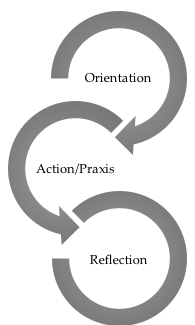Service-Learning
In This Section
In This Section
This section of our website will tell you about service learning — what it means, how it works and how to become involved. If you are simply seeking a volunteer opportunity, visit our Volunteer Programs page.
Service-Learning is a teaching and learning strategy that integrates meaningful community service with instruction and reflection to enrich the learning experience, teach civic responsibility and strengthen communities.
Service-Learning Definition
Sacred Heart University’s Service-Learning Council (SLC) acknowledges the value of all types of community engagement, from volunteerism and mission work to internships. The purpose of the SLC is to focus its attention in on service-learning as a high impact pedagogical strategy. What follows is the SLC’s agreed upon definition of service-learning. It is intended to be a guide to faculty in designing and re-designing courses using this high impact pedagogy and in no way strives to define or restrict other types of community engaged activities.
The SLC defines service-learning as follows:
Service-learning is a credit-bearing, faculty-directed, teaching-learning experience that is course specific. Service-learning strengthens academic content knowledge and sense of civic responsibility. Students build critical thinking skills as they engage in experiential, community-based activities that are aligned with and integral to academic course work. At the same time, the community (real people in real situations) benefits from assistance that would otherwise not be available.
Components of Service-Learning
The Office of Community Engagement incorporates three components into each service-learning opportunity. Faculty are encouraged to utilize the following components in course development:
 Orientation/Preparation
Orientation/Preparation
Students are introduced to relevant social issues and the community through course content.
Action/Praxis
Students participate in hands-on, project-based activities that enhance learning, address the identified social issue, and promote community interest.
Reflection
Students are challenged to think critically about the questions of “So what?” and “Now what?” Through structured reflections, participants are asked to address critical moments and to begin considering viable solutions that will create sustainable social change.
These three components distinguish service-learning from other student engagement activities like internships, work study, experiential learning, and/or clinical care experiences. Students and faculty engage in service-learning programs because they aspire to achieve prominence through innovative teaching and learning while cultivating a campus community that is recognized as caring and creative.
Student Learning Objectives & Community Benefit
- To foster the mission and identity of the University and the preservation of its core values, including the promotion of the common good of society and the recognition of the dignity and worth of every human being
- To practice and improve on competencies that are necessary to develop good leadership and project management skills
- To gain a genuine appreciation of social diversity and inclusion while working alongside community partners
- To provide community organizations with a committed partner who will assist in their pursuit for viable social justice solutions
Courses include the following best practices:
- Service-learning is both a teaching strategy and philosophy used to develop students into citizens who contribute to their communities and promote social justice (SHU Mission; Speck, 2001).
- Service-learning is integrated into curricula, related to specific learning objectives that are outlined on course syllabi with student assessment and academic credit based on learning outcomes—not on the service.
- Service-learning and the community partners are equal in determining the service-learning experience and should be outlined in a plan of mutual benefit to students and the community partner(s) and articulates the needs and expectations of both.
- Service-learning integrates critical reflection that requires students to relate the experience to the course learning objectives and outcomes, social justice, professional values, and students’ personal values and perceptions (Evers, 2010).
- Service-learning is along the continuum of activities that includes volunteerism, community service, mission work, field education, and internships. Service-learning is differentiated by its focus and intended beneficiary. Service-learning is unique in its mutual benefit to the recipient (community partners) and service provider (students) with an equal focus on service and students’ learning (Furco, 1996).
Furco’s typology. Furco (1996) developed a typology continuum to distinguish among the various forms of service. The degree to which the activity focused on the intended beneficiary and degree to which the activity focused on students’ learning determines its place along the service continuum.

Bibliography & References
- Dary, T. (2012, February 28). The academic service learning answer to student engagement.
- Dary, T. (2010, April). Highly quality instruction that transforms: A guide to implementing quality academic service learning. Wisconsin Department of Public Instruction.
- Furco, A. (1996). Service learning: A balanced approach to experiential education: Service and learning. Washington DC Corporation for National Service. 2-6.
- Speck, B.W. (2001, Summer). New directions for higher education: Developing and implementing service learning programs 2001(114), 3-13. DOI: 10.1002/he.8
View the separate sections of our website for faculty, students and community partners. As you explore, if you have any questions, contact our office at 203-365-4710.
 Orientation/Preparation
Orientation/Preparation